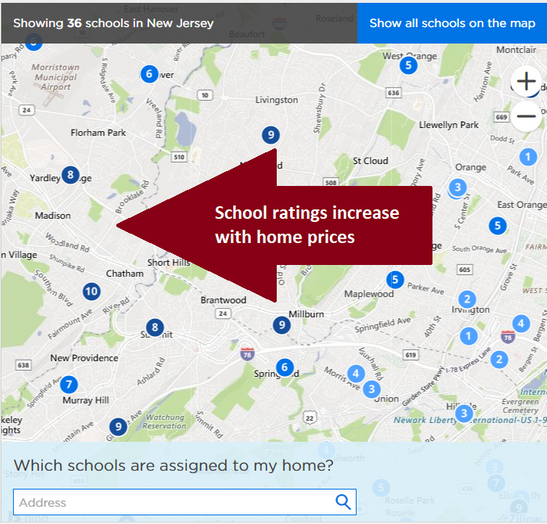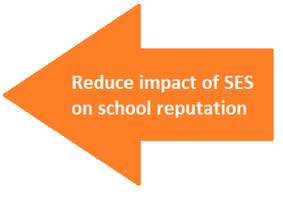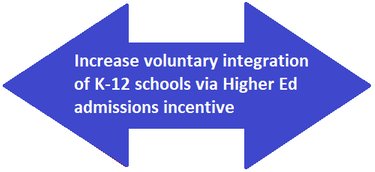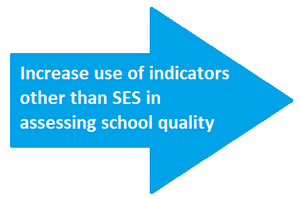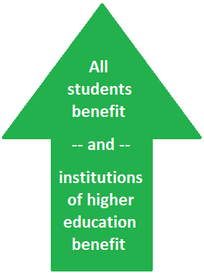SchoolBonusPoints
BACKGROUND
Why use School Bonus Points to encourage voluntary integration of K-12 schools?
Screenshot from an online real estate website, Zillow.com (April 2018). This shows ratings of public high schools across several towns in NJ, ranging from 1 (low) to 10 (high), as calculated by a nonprofit school ratings provider.
The search function at the bottom allows users to enter an address. The website then lists schools associated with the address, along with each school's rating.
2. Market forces financially reinforce segregation.
The reputation and ratings of schools influences housing markets and neighborhood demographics (e.g., Bayer, Ferreira & McMillan, 2007; Glynn & Waldeck, 2013).
Tremendous challenges exist in housing and school integration efforts because of market forces that financially reinforce the opposite: segregation. "School quality" drives demand for schools and their associated neighborhoods (National Association of Realtors, 2011). But popular indicators of "school quality," such as the ratings in the screenshot above, are more related to income of the students at the school, than how well the school serves its students (e.g., Toutkoushian & Curtis, 2005).
Specifically, as wealth of the students at a school is related to school ratings, and as school ratings drive the demand for homes in associated neighborhoods, the result is increased economic and racial segregation of schools and neighborhoods.
3. An incentive to encourage voluntary integration is needed.
This incentive needs to function in the opposite direction of current market forces.
This project proposes to create such an integration incentive: Bonus points in admissions formulas for students applying to selective colleges and universities from economically disadvantaged K-12 schools. These points would provide slightly higher chances of acceptance than a student’s application taken alone. The higher the proportion of economically disadvantaged students at a K-12 school, the more admissions bonus points the school would have associated with it.
By formalizing these point values, and publicizing their use in higher education admissions, School Bonus Points would provide an incentive for voluntary integration of K-12 schools and neighborhoods. The K-12 schools with higher amounts of bonus points would become more attractive.
4. School Bonus Points provide a higher education admissions incentive for parents to examine indicators unrelated to SES in assessing K-12 school quality. And it is a method permissible within current law for promoting diversity of the student body at institutions of higher education.
Scott-Railton's (2018) seminal article on this topic, titled Shifting the Scope: How Taking School Demographics Into Account in College Admissions Could Reduce K-12 Segregation Nationwide and published by the Yale Law & Policy Review, provides an initial examination of the constitutionality and potential effectiveness of such an approach. This concept has the potential to both increase integration in K-12 schools and foster diversity in institutions of higher education. This School Bonus Points project will refine and implement the concept outlined in the article.
5. Voluntary integration using School Bonus Points would benefit all students in K-12, as well as benefit institutions of higher education.
Goals of the School Bonus Points incentive:
Foster school, classroom, and neighborhood integration. This improves learning for all students by enhancing attributes related to academic success such as satisfaction, motivation, self-confidence, critical thinking, and problem solving (e.g., Wells, Fox & Cordova-Cobo, 2016).
Provide an additional boost for low-SES students at K-12 low-SES schools by increasing chances of admissions to selective colleges and universities.
Increase external financial resources accessible to lower-SES schools (e.g., PTA funds).
Reduce impact of school SES on school reputation, and increase use of other indicators to evaluate school quality.
Increase stability of home values as demographics shift across neighborhoods and their associated K-12 schools.
Foster diversity at institutions of higher education by race and class.
1. School ratings are not necessarily indicators of school quality.
“…the most coveted schools are, from the most privileged parents’ perspectives, those schools without low-income students or students of color” (Holme, 2002, p. 203).
This screenshot illustrates Holme's finding.
In the region shown, schools on the right (east) have lower ratings, and correspond to neighborhoods with lower-priced homes and higher proportions of Black and Hispanic students.
Schools on the left (west) have higher ratings, and correspond to neighborhoods with higher-priced homes and higher proportions of White and Asian students.
Higher ratings tend to be associated with higher-priced homes, thus these ratings are more a socioeconomic indicator than they are an accurate reflection of school "quality." Glynn & Waldeck (2013) provide a clear example of this issue by comparing two schools shown here.
